Mapping Crop Types and Cropping Patterns Using Multiple-Source Satellite Datasets in Subtropical Hilly and Mountainous Region of China
Abstract
1. Introduction
2. Study Area and Data Source
2.1. Overview of the Study Sites
2.2. Satellite Data and Preprocessing
2.3. Field Samples
3. Methods
3.1. Classification Framework
3.2. Variables’ Extraction and Selection
3.2.1. Variables’ Extraction
- (1)
- Spectral bands and indices
- (2)
- Phenology indices
- (3)
- Textures
- (4)
- Endmember variables
- (5)
- SAR variables
- (6)
- Terrains
3.2.2. Variables Selection
3.3. Random Forest Classifier
3.4. Post-Classification Processing
3.4.1. Majority Filter
3.4.2. Parcel Boundaries’ Improvement Using Multiresolution Segmentation
3.5. Accuracy Assessment
4. Results
4.1. Contribution of Different Remote Sensing Variables
4.2. Classification Performance of Crop Types and Cropping Patterns
4.2.1. Performance of Multi-Scale Segmentation
4.2.2. Performance of Mapped Crop Types
4.2.3. Comparison with Existing Products
4.3. Spatial Distribution of Crop Types and Cropping Patterns
5. Discussions
5.1. Potential of Combining Multi-Source Data in Crop Type Classification
5.2. Classification Algorithm’s Selection
5.3. Shortcomings and Prospects
6. Conclusions
Author Contributions
Funding
Data Availability Statement
Conflicts of Interest
References
- Bisht, I.S.; Mehta, P.S.; Negi, K.S.; Verma, S.K.; Tyagi, R.K.; Garkoti, S.C. Farmers’ rights, local food systems, and sustainable household dietary diversification: A case of Uttarakhand Himalaya in north-western India. Agroecol. Sustain. Food Syst. 2018, 42, 77–113. [Google Scholar] [CrossRef]
- Alemu, M.M. Sustainable land management. J. Environ. Prot. 2016, 7, 502–506. [Google Scholar] [CrossRef]
- Zhang, Z.; Zheng, L.; Yu, D. Non-Grain Production of Cultivated Land in Hilly and Mountainous Areas at the Village Scale: A Case Study in Le’an Country, China. Land 2023, 12, 1562. [Google Scholar] [CrossRef]
- Chen, Y.; Lu, D.; Moran, E.; Batistella, M.; Dutra, L.V.; Sanches, I.D.A.; da Silva, R.F.B.; Huang, J.; Luiz, A.J.B.; de Oliveira, M.A.F. Mapping croplands, cropping patterns, and crop types using MODIS time-series data. Int. J. Appl. Earth Obs. 2018, 69, 133–147. [Google Scholar] [CrossRef]
- Song, X.-P.; Huang, W.; Hansen, M.C.; Potapov, P. An evaluation of Landsat, Sentinel-2, Sentinel-1 and MODIS data for crop type mapping. Sci. Remote Sens. 2021, 3, 100018. [Google Scholar] [CrossRef]
- Dash, P.; Sanders, S.L.; Parajuli, P.; Ouyang, Y. Improving the Accuracy of Land Use and Land Cover Classification of Landsat Data in an Agricultural Watershed. Remote Sens. 2023, 15, 4020. [Google Scholar] [CrossRef]
- Schlund, M.; Erasmi, S. Sentinel-1 time series data for monitoring the phenology of winter wheat. Remote Sens. Environ. 2020, 246, 111814. [Google Scholar] [CrossRef]
- Villa, P.; Stroppiana, D.; Fontanelli, G.; Azar, R.; Brivio, P.A. In-Season Mapping of Crop Type with Optical and X-Band SAR Data: A Classification Tree Approach Using Synoptic Seasonal Features. Remote Sens. 2015, 7, 12859–12886. [Google Scholar] [CrossRef]
- Chen, J.; Zhang, Z. An improved fusion of Landsat-7/8, Sentinel-2, and Sentinel-1 data for monitoring alfalfa: Implications for crop remote sensing. Int. J. Appl. Earth Obs. 2023, 124, 103533. [Google Scholar] [CrossRef]
- Qiu, B.; Lin, D.; Chen, C.; Yang, P.; Tang, Z.; Jin, Z.; Ye, Z.; Zhu, X.; Duan, M.; Huang, H.; et al. From cropland to cropped field: A robust algorithm for national-scale mapping by fusing time series of Sentinel-1 and Sentinel-2. Int. J. Appl. Earth Obs. 2022, 113, 103006. [Google Scholar] [CrossRef]
- Demarez, V.; Helen, F.; Marais-Sicre, C.; Baup, F. In-Season Mapping of Irrigated Crops Using Landsat 8 and Sentinel-1 Time Series. Remote Sens. 2019, 11, 118. [Google Scholar] [CrossRef]
- Chakhar, A.; Ortega-Terol, D.; Hernández-López, D.; Ballesteros, R.; Ortega, J.F.; Moreno, M.A. Assessing the Accuracy of Multiple Classification Algorithms for Crop Classification Using Landsat-8 and Sentinel-2 Data. Remote Sens. 2020, 12, 1735. [Google Scholar] [CrossRef]
- Blickensdörfer, L.; Schwieder, M.; Pflugmacher, D.; Nendel, C.; Erasmi, S.; Hostert, P. Mapping of crop types and crop sequences with combined time series of Sentinel-1, Sentinel-2 and Landsat 8 data for Germany. Remote Sens. Environ. 2022, 269, 112831. [Google Scholar] [CrossRef]
- Howard, D.M.; Wylie, B.K.; Tieszen, L.L. Crop classification modelling using remote sensing and environmental data in the Greater Platte River Basin, USA. Int. J. Remote Sens. 2012, 33, 6094–6108. [Google Scholar] [CrossRef]
- Shrestha, D.P.; Zinck, J.A. Land use classification in mountainous areas: Integration of image processing, digital elevation data and field knowledge (application to Nepal). Int. J. Appl. Earth Obs. 2001, 3, 78–85. [Google Scholar] [CrossRef]
- Lebourgeois, V.; Dupuy, S.; Vintrou, É.; Ameline, M.; Butler, S.; Bégué, A. A Combined Random Forest and OBIA Classification Scheme for Mapping Smallholder Agriculture at Different Nomenclature Levels Using Multisource Data (Simulated Sentinel-2 Time Series, VHRS and DEM). Remote Sens. 2017, 9, 259. [Google Scholar] [CrossRef]
- Tian, X.; Chen, Z.; Li, Y.; Bai, Y. Crop Classification in Mountainous Areas Using Object-Oriented Methods and Multi-Source Data: A Case Study of Xishui County, China. Agronomy 2023, 13, 3037. [Google Scholar] [CrossRef]
- Yang, S.; Gu, L.; Li, X.; Jiang, T.; Ren, R. Crop Classification Method Based on Optimal Feature Selection and Hybrid CNN-RF Networks for Multi-Temporal Remote Sensing Imagery. Remote Sens. 2020, 12, 3119. [Google Scholar] [CrossRef]
- Löw, F.; Michel, U.; Dech, S.; Conrad, C. Impact of feature selection on the accuracy and spatial uncertainty of per-field crop classification using Support Vector Machines. ISPRS J. Photogramm. 2013, 85, 102–119. [Google Scholar] [CrossRef]
- Hu, Q.; Sulla-Menashe, D.; Xu, B.; Yin, H.; Tang, H.; Yang, P.; Wu, W. A phenology-based spectral and temporal feature selection method for crop mapping from satellite time series. Int. J. Appl. Earth Obs. 2019, 80, 218–229. [Google Scholar] [CrossRef]
- Qiu, B.; Yu, L.; Yang, P.; Wu, W.; Chen, J.; Zhu, X.; Duan, M. Mapping upland crop–rice cropping systems for targeted sustainable intensification in South China. Crop J. 2024, 12, 614–629. [Google Scholar] [CrossRef]
- Zang, Y.; Qiu, Y.; Chen, X.; Chen, J.; Yang, W.; Liu, Y.; Peng, L.; Shen, M.; Cao, X. Mapping rapeseed in China during 2017-2021 using Sentinel data: An automated approach integrating rule-based sample generation and a one-class classifier (RSG-OC). Gisci. Remote Sens. 2023, 60, 2163576. [Google Scholar] [CrossRef]
- Liu, W.; Li, S.; Tao, J.; Liu, X.; Yin, G.; Xia, Y.; Wang, T.; Zhang, H. CARM30: China annual rapeseed maps at 30 m spatial resolution from 2000 to 2022 using multi-source data. Sci. Data 2024, 11, 356. [Google Scholar] [CrossRef] [PubMed]
- Liu, S.; Wang, L.; Zhang, J. The dataset of main grain land changes in China over 1985–2020. Sci. Data 2024, 11, 1430. [Google Scholar] [CrossRef]
- Shen, R.; Pan, B.; Peng, Q.; Dong, J.; Chen, X.; Zhang, X.; Ye, T.; Huang, J.; Yuan, W. High-resolution distribution maps of single-season rice in China from 2017 to 2022. Earth Syst. Sci. Data 2023, 15, 3203–3222. [Google Scholar] [CrossRef]
- Waldner, F.; Diakogiannis, F.I.; Batchelor, K.; Ciccotosto-Camp, M.; Cooper-Williams, E.; Herrmann, C.; Mata, G.; Toovey, A. Detect, Consolidate, Delineate: Scalable Mapping of Field Boundaries Using Satellite Images. Remote Sens. 2021, 13, 2197. [Google Scholar] [CrossRef]
- Rouse, J.W.; Haas, R.H.; Schell, J.A.; Deering, D.W. Monitoring vegetation systems in the Great Plains with ERTS. NASA Spec. Publ. 1974, 351, 309. [Google Scholar]
- Zha, Y.; Gao, J.; Ni, S. Use of normalized difference built-up index in automatically mapping urban areas from TM imagery. Int. J. Remote Sens. 2003, 24, 583–594. [Google Scholar] [CrossRef]
- Xu, H. Modification of normalised difference water index (NDWI) to enhance open water features in remotely sensed imagery. Int. J. Remote Sens. 2006, 27, 3025–3033. [Google Scholar] [CrossRef]
- Zhong, L.; Gong, P.; Biging, G.S. Efficient corn and soybean mapping with temporal extendability: A multi-year experiment using Landsat imagery. Remote Sens. Environ. 2014, 140, 1–13. [Google Scholar] [CrossRef]
- Zhang, H.; Liu, W.; Zhang, L. Seamless and automated rapeseed mapping for large cloudy regions using time-series optical satellite imagery. ISPRS J. Photogramm. 2022, 184, 45–62. [Google Scholar] [CrossRef]
- Didan, K.; Munoz, A.B.; Solano, R.; Huete, A. MODIS vegetation index user’s guide (MOD13 series). Univ. Ariz. Veg. Index Phenol. Lab 2015, 35, 2–33. [Google Scholar]
- Yang, J.; Hu, Q.; Li, W.; Song, Q.; Cai, Z.; Zhang, X.; Wei, H.; Wu, W. An automated sample generation method by integrating phenology domain optical-SAR features in rice cropping pattern mapping. Remote Sens. Environ. 2024, 314, 114387. [Google Scholar] [CrossRef]
- Zhu, A.X.; Zhao, F.-H.; Pan, H.-B.; Liu, J.-Z. Mapping Rice Paddy Distribution Using Remote Sensing by Coupling Deep Learning with Phenological Characteristics. Remote Sens. 2021, 13, 1360. [Google Scholar] [CrossRef]
- Meng, L.; Li, Y.; Shen, R.; Zheng, Y.; Pan, B.; Yuan, W.; Li, J.; Zhuo, L. Large-scale and high-resolution paddy rice intensity mapping using downscaling and phenology-based algorithms on Google Earth Engine. Int. J. Appl. Earth Obs. 2024, 128, 103725. [Google Scholar] [CrossRef]
- Zhao, Z.; Dong, J.; Zhang, G.; Yang, J.; Liu, R.; Wu, B.; Xiao, X. Improved phenology-based rice mapping algorithm by integrating optical and radar data. Remote Sens. Environ. 2024, 315, 114460. [Google Scholar] [CrossRef]
- Haralick, R.M.; Shanmugam, K.; Dinstein, I. Textural Features for Image Classification. IEEE t. Syst. Man. Cybern. 1973, SMC-3, 610–621. [Google Scholar] [CrossRef]
- Breiman, L. Random Forests. Mach. Learn. 2001, 45, 5–32. [Google Scholar] [CrossRef]
- Huang, Z.; Jing, H.; Liu, Y.; Yang, X.; Wang, Z.; Liu, X.; Gao, K.; Luo, H. Segment Anything Model Combined with Multi-Scale Segmentation for Extracting Complex Cultivated Land Parcels in High-Resolution Remote Sensing Images. Remote Sens. 2024, 16, 3489. [Google Scholar] [CrossRef]
- Foody, G.M. Status of land cover classification accuracy assessment. Remote Sens. Environ. 2002, 80, 185–201. [Google Scholar] [CrossRef]
- Dice, L.R. Measures of the amount of ecologic association between species. Ecology 1945, 26, 297–302. [Google Scholar] [CrossRef]
- Chen, Y.; Zhao, S.; Xie, Z.; Lu, D.; Chen, E. Mapping multiple tree species classes using a hierarchical procedure with optimized node variables and thresholds based on high spatial resolution satellite data. Gisci. Remote Sens. 2020, 57, 526–542. [Google Scholar] [CrossRef]
- Pan, B.; Zheng, Y.; Shen, R.; Ye, T.; Zhao, W.; Dong, J.; Ma, H.; Yuan, W. High Resolution Distribution Dataset of Double-Season Paddy Rice in China. Remote Sens. 2021, 13, 4609. [Google Scholar] [CrossRef]
- Khanal, S.; Kc, K.; Fulton, J.P.; Shearer, S.; Ozkan, E. Remote Sensing in Agriculture—Accomplishments, Limitations, and Opportunities. Remote Sens. 2020, 12, 3783. [Google Scholar] [CrossRef]
- Li, Z.; Shen, H.; Weng, Q.; Zhang, Y.; Dou, P.; Zhang, L. Cloud and cloud shadow detection for optical satellite imagery: Features, algorithms, validation, and prospects. ISPRS J. Photogramm. 2022, 188, 89–108. [Google Scholar] [CrossRef]
- Chen, B.; Huang, B.; Xu, B. Multi-source remotely sensed data fusion for improving land cover classification. ISPRS J. Photogramm. 2017, 124, 27–39. [Google Scholar] [CrossRef]
- Xu, S.; Zhu, X.; Chen, J.; Zhu, X.; Duan, M.; Qiu, B.; Wan, L.; Tan, X.; Xu, Y.N.; Cao, R. A robust index to extract paddy fields in cloudy regions from SAR time series. Remote Sens. Environ. 2023, 285, 113374. [Google Scholar] [CrossRef]
- Wang, X.; Zhang, J.; Xun, L.; Wang, J.; Wu, Z.; Henchiri, M.; Zhang, S.; Zhang, S.; Bai, Y.; Yang, S. Evaluating the effectiveness of machine learning and deep learning models combined time-series satellite data for multiple crop types classification over a large-scale region. Remote Sens. 2022, 14, 2341. [Google Scholar] [CrossRef]
- Mpakairi, K.S.; Dube, T.; Sibanda, M.; Mutanga, O. Fine-scale characterization of irrigated and rainfed croplands at national scale using multi-source data, random forest, and deep learning algorithms. ISPRS J. Photogramm. 2023, 204, 117–130. [Google Scholar] [CrossRef]
- Zhou, X.; Wang, J.; He, Y.; Shan, B. Crop Classification and Representative Crop Rotation Identifying Using Statistical Features of Time-Series Sentinel-1 GRD Data. Remote Sens. 2022, 14, 5116. [Google Scholar] [CrossRef]
- Fei, H.; Fan, Z.; Wang, C.; Zhang, N.; Wang, T.; Chen, R.; Bai, T. Cotton Classification Method at the County Scale Based on Multi-Features and Random Forest Feature Selection Algorithm and Classifier. Remote Sens. 2022, 14, 829. [Google Scholar] [CrossRef]
- Li, H.; Song, X.-P.; Hansen, M.C.; Becker-Reshef, I.; Adusei, B.; Pickering, J.; Wang, L.; Wang, L.; Lin, Z.; Zalles, V.; et al. Development of a 10-m resolution maize and soybean map over China: Matching satellite-based crop classification with sample-based area estimation. Remote Sens. Environ. 2023, 294, 113623. [Google Scholar] [CrossRef]
- Chen, Y.; Li, X.; Liu, X.; Ai, B. Analyzing land-cover change and corresponding impacts on carbon budget in a fast developing sub-tropical region by integrating MODIS and Landsat TM/ETM+ images. Appl. Geogr. 2013, 45, 10–21. [Google Scholar] [CrossRef]
- Yin, Z.; Song, X.; Zhou, B.; Jiang, W.; Chen, H.; Wang, H. Traditional Meiyu–Baiu has been suspended by global warming. Natl. Sci. Rev. 2024, 11, nwae166. [Google Scholar] [CrossRef] [PubMed]
- Wang, Y.; Fang, S.; Zhao, L.; Huang, X.; Jiang, X. Parcel-based summer maize mapping and phenology estimation combined using Sentinel-2 and time series Sentinel-1 data. Int. J. Appl. Earth Obs. 2022, 108, 102720. [Google Scholar] [CrossRef]
- Yu, Z.; Kuang, L.; Jiang, Y.; Li, W.; Zhang, J.; Zhou, Y.; Guo, X.; Ye, Y. Soil attributes are more important than others in shaping the diversity of cultivated land quality types, southern China. Ecol. Indic. 2024, 166, 112472. [Google Scholar] [CrossRef]
- Mahlayeye, M.; Darvishzadeh, R.; Nelson, A. Cropping Patterns of Annual Crops: A Remote Sensing Review. Remote Sens. 2022, 14, 2404. [Google Scholar] [CrossRef]
- Cui, Z.; Zhang, H.; Chen, X.; Zhang, C.; Ma, W.; Huang, C.; Zhang, W.; Mi, G.; Miao, Y.; Li, X.; et al. Pursuing sustainable productivity with millions of smallholder farmers. Nature 2018, 555, 363–366. [Google Scholar] [CrossRef]
- Attri, I.; Awasthi, L.K.; Sharma, T.P.; Rathee, P. A review of deep learning techniques used in agriculture. Ecol. Inform. 2023, 77, 102217. [Google Scholar] [CrossRef]
- Aduvukha, G.R.; Abdel-Rahman, E.M.; Sichangi, A.W.; Makokha, G.O.; Landmann, T.; Mudereri, B.T.; Tonnang, H.E.Z.; Dubois, T. Cropping Pattern Mapping in an Agro-Natural Heterogeneous Landscape Using Sentinel-2 and Sentinel-1 Satellite Datasets. Agriculture 2021, 11, 530. [Google Scholar] [CrossRef]
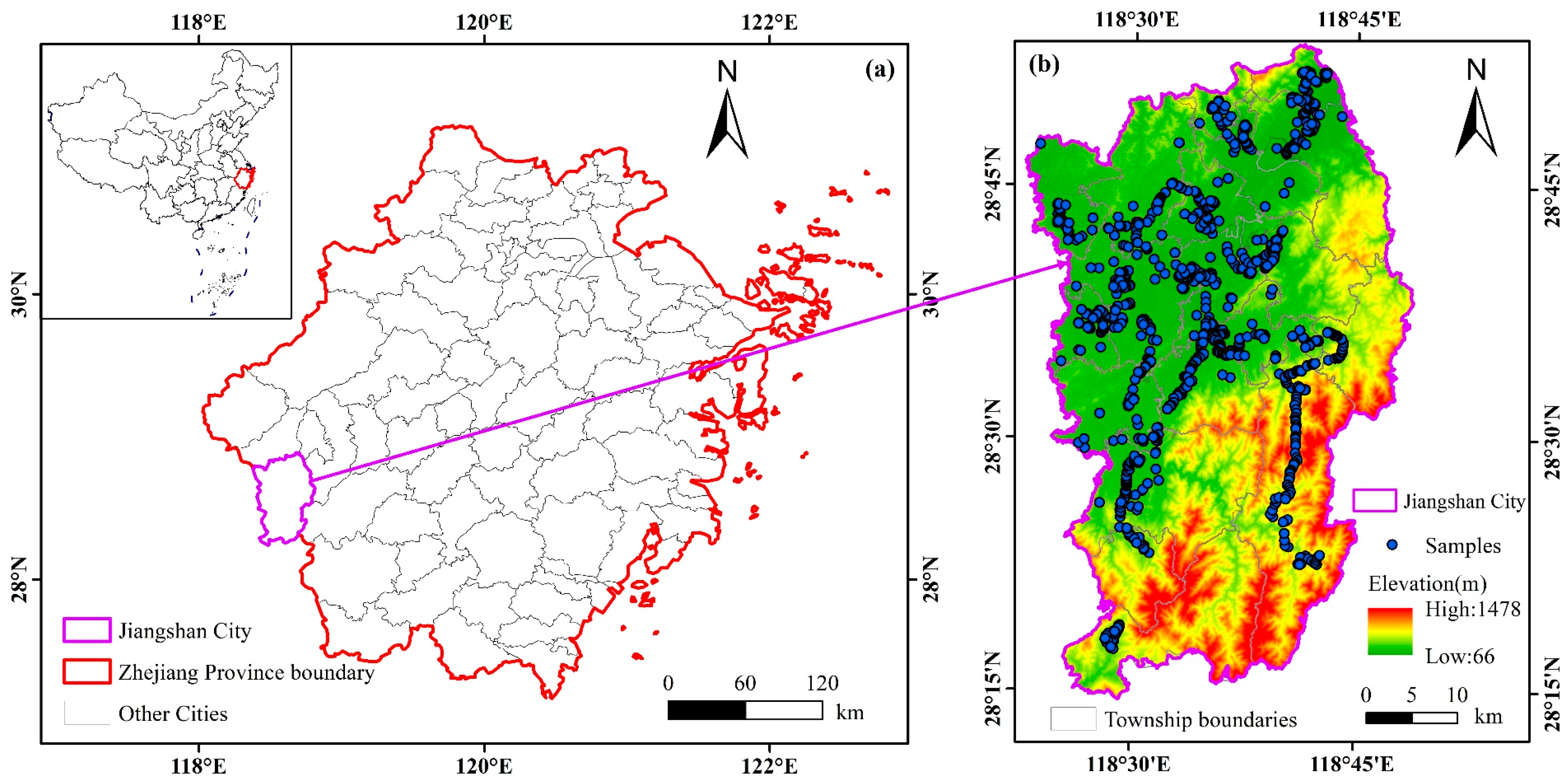
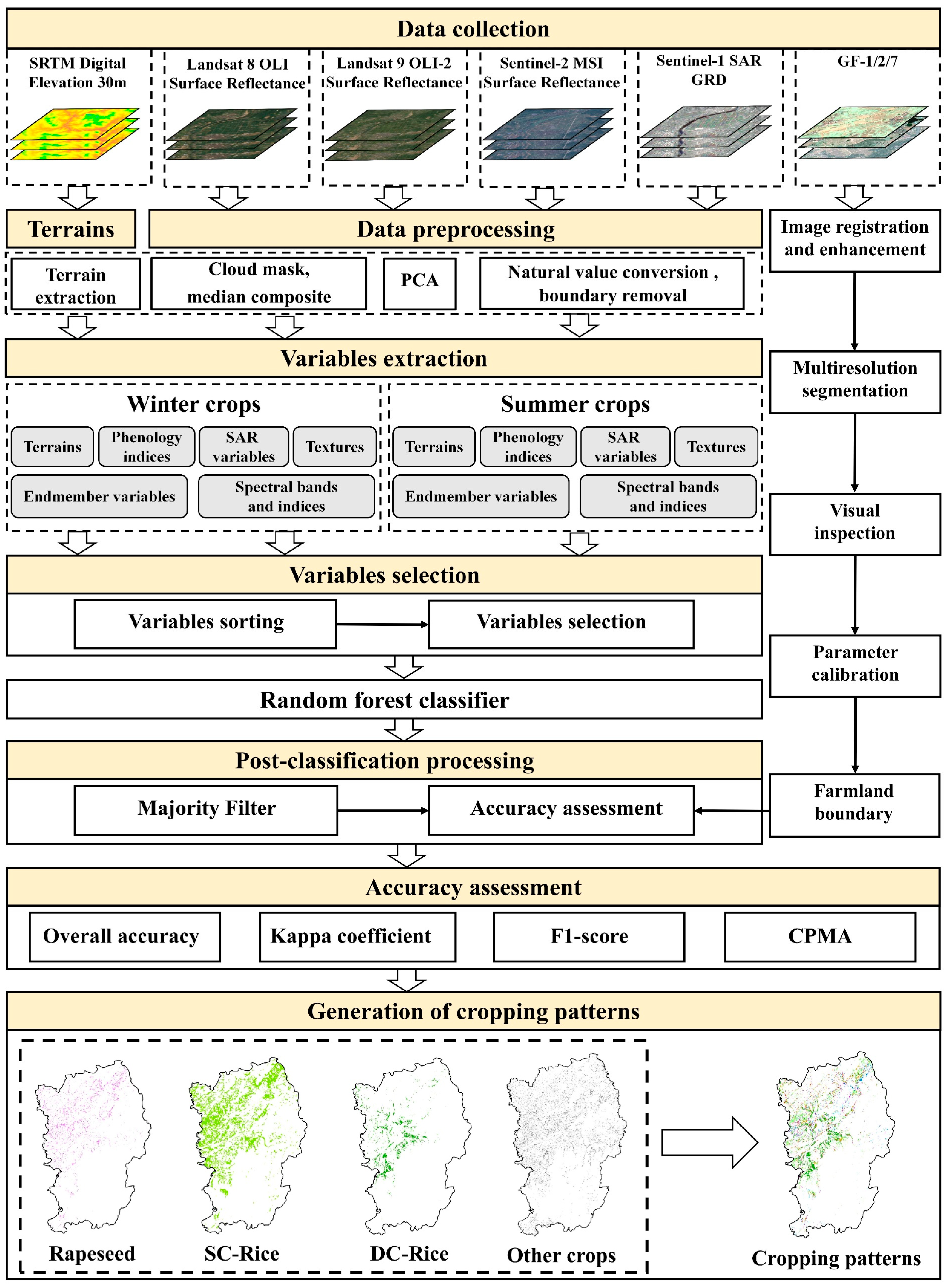
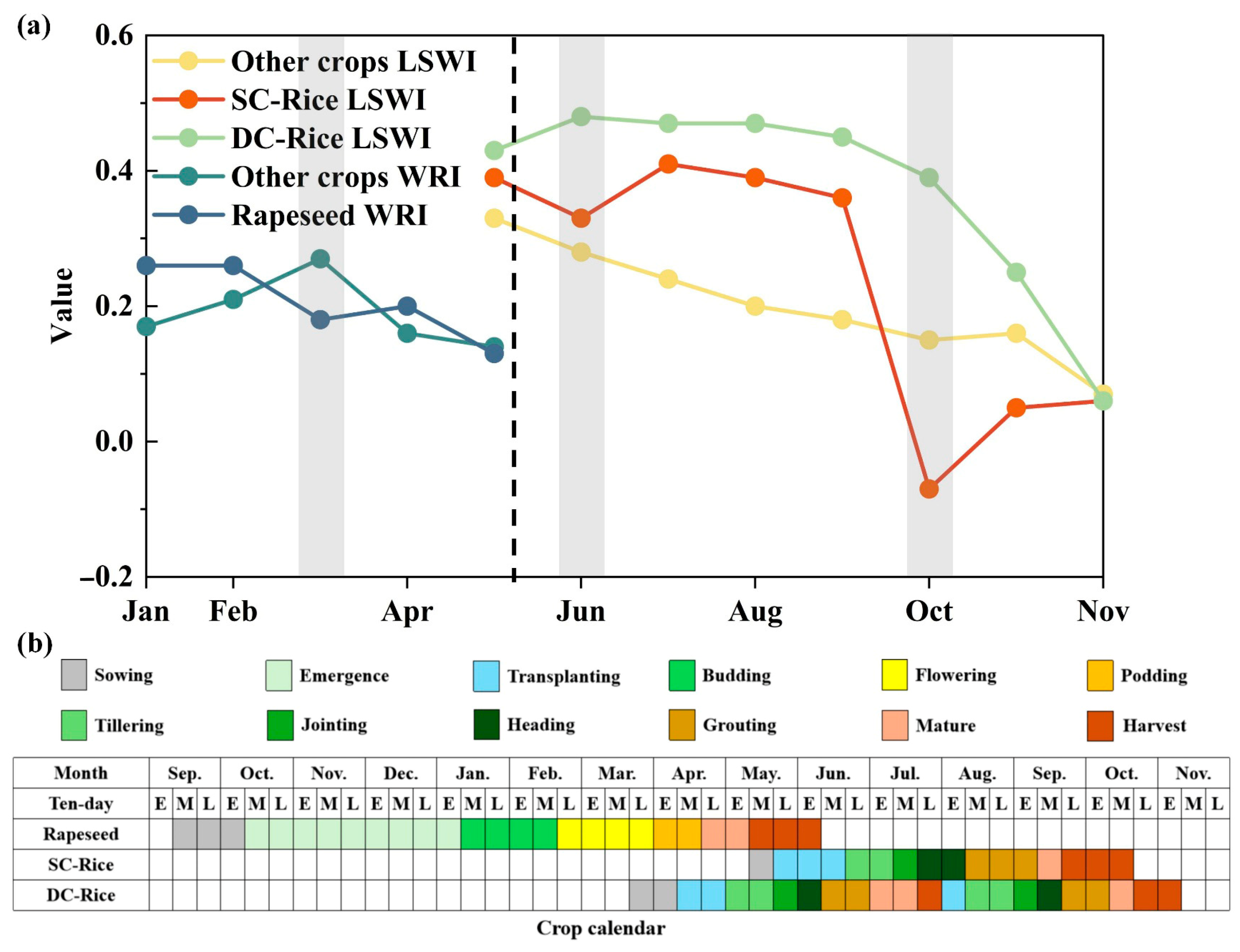




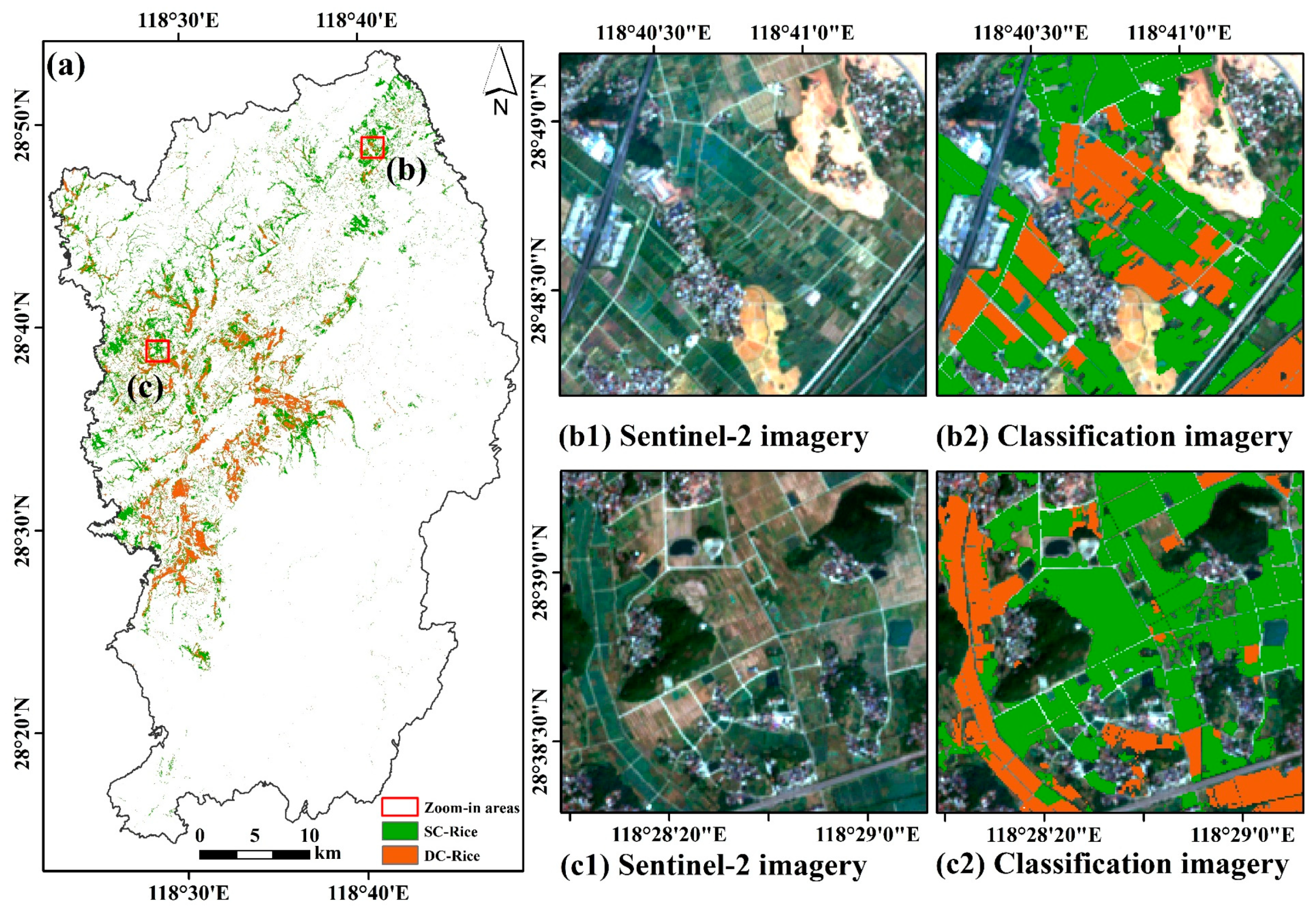

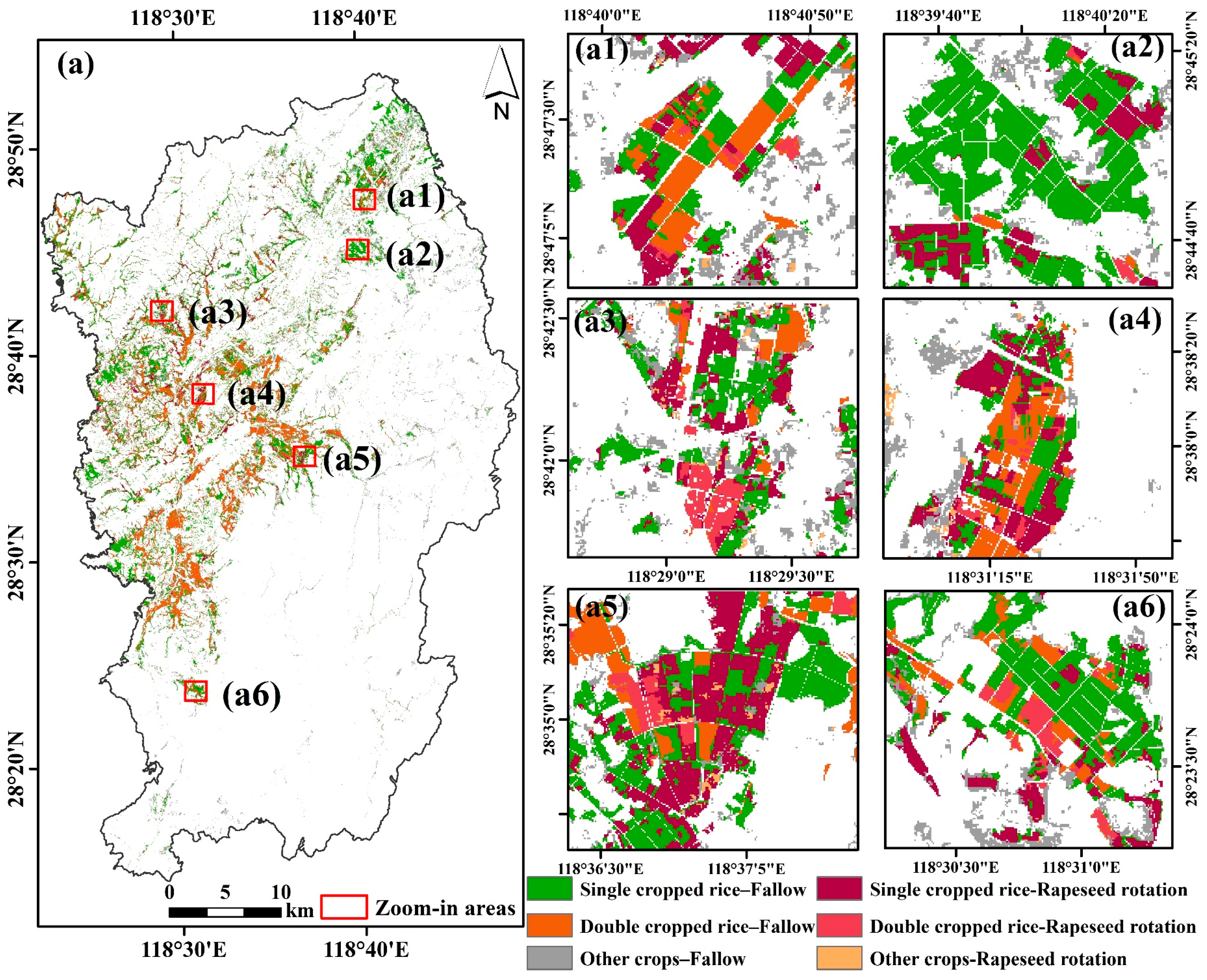


| Dataset | Temporal Resolution | Spatial Resolution for Used Bands | |
|---|---|---|---|
| Medium spatial resolution optical imagery | Landsat 8 OLI | 16 days | 30 m for blue, green, red, near-infrared, and two shortwave infrared bands |
| Landsat 9 OLI-2 | 16 days | ||
| Sentinel-2A | 5 days | 10 m for blue, green, red and near-infrared and 20 m for three red-edge bands | |
| High spatial resolution optical imagery | GF-1 | 4 days | 8 m for blue, green, red, and near-infrared and 2 m for panchromatic band |
| GF-2 | 69 days | 4 m for blue, green, red, and near-infrared and 1 m for panchromatic band | |
| GF-7 | 26 days | 2.6 m for blue, green, red, and near-infrared and 0.65 m for panchromatic band | |
| Microwave imagery | Sentinel-1 | 12 days | 10 m for VV, VH, ratio in GRD products |
| Digital elevation | SRTM | - | 30 m |
| Crop Type | Winter Classification | Summer Classification | ||
|---|---|---|---|---|
| Training Samples | Verification Sample | Training Samples | Verification Sample | |
| SC-Rice | / | / | 210 | 90 |
| DC-Rice | / | / | 166 | 71 |
| Rapeseed | 70 | 30 | / | / |
| Other crops | 98 | 42 | 138 | 59 |
| Forests | 61 | 26 | 98 | 42 |
| Shrubs | 49 | 21 | 94 | 40 |
| Water bodies | 38 | 16 | 91 | 39 |
| Impervious surfaces | 66 | 28 | 133 | 57 |
| Total | 382 | 163 | 930 | 398 |
| Spectral Indices | Formula | References |
|---|---|---|
| NDVI | [27] | |
| NDBI | [28] | |
| MNDWI | [29] | |
| LSWI | [30] | |
| WRI | [31] | |
| EVI | [32] |
| Crop Type | Data Inclusion | OA (%) | Kappa | F1 (%) | CPMA (%) | |
|---|---|---|---|---|---|---|
| Winter classification | Rapeseed | All data | 96.93 | 0.96 | 96.55 | 96.96 |
| Exclusion of SAR data | 96.31 | 0.95 | 96.54 | 96.66 | ||
| Summer classification | Single-cropped rice | All data | 95.61 | 0.95 | 92.37 | 91.63 |
| Exclusion of SAR data | 91.48 | 0.91 | 91.63 | 90.89 | ||
| Double-cropped rice | All data | 95.61 | 0.95 | 96.83 | 96.83 | |
| Exclusion of SAR data | 91.48 | 0.91 | 95.95 | 96.11 |
| Crop Type | Yearbook Area (km2) | Liu et al. (2024) [23] (km2) | Shen et al. (2023) [25] (km2) | Pan et al. (2021) [43] (km2) | This Study (km2) |
|---|---|---|---|---|---|
| Rapeseed | 63.50 | 34.64 | / | / | 63.09 |
| Single-cropped rice | 92.98 | / | 93.44 | / | 91.63 |
| Double-cropped rice | 55.97 | / | / | 48.46 | 53.99 |
Disclaimer/Publisher’s Note: The statements, opinions and data contained in all publications are solely those of the individual author(s) and contributor(s) and not of MDPI and/or the editor(s). MDPI and/or the editor(s) disclaim responsibility for any injury to people or property resulting from any ideas, methods, instructions or products referred to in the content. |
© 2025 by the authors. Licensee MDPI, Basel, Switzerland. This article is an open access article distributed under the terms and conditions of the Creative Commons Attribution (CC BY) license (https://creativecommons.org/licenses/by/4.0/).
Share and Cite
Chen, Y.; Xu, Z.; Xu, H.; Xu, Z.; Wang, D.; Yan, X. Mapping Crop Types and Cropping Patterns Using Multiple-Source Satellite Datasets in Subtropical Hilly and Mountainous Region of China. Remote Sens. 2025, 17, 2282. https://doi.org/10.3390/rs17132282
Chen Y, Xu Z, Xu H, Xu Z, Wang D, Yan X. Mapping Crop Types and Cropping Patterns Using Multiple-Source Satellite Datasets in Subtropical Hilly and Mountainous Region of China. Remote Sensing. 2025; 17(13):2282. https://doi.org/10.3390/rs17132282
Chicago/Turabian StyleChen, Yaoliang, Zhiying Xu, Hongfeng Xu, Zhihong Xu, Dacheng Wang, and Xiaojian Yan. 2025. "Mapping Crop Types and Cropping Patterns Using Multiple-Source Satellite Datasets in Subtropical Hilly and Mountainous Region of China" Remote Sensing 17, no. 13: 2282. https://doi.org/10.3390/rs17132282
APA StyleChen, Y., Xu, Z., Xu, H., Xu, Z., Wang, D., & Yan, X. (2025). Mapping Crop Types and Cropping Patterns Using Multiple-Source Satellite Datasets in Subtropical Hilly and Mountainous Region of China. Remote Sensing, 17(13), 2282. https://doi.org/10.3390/rs17132282






